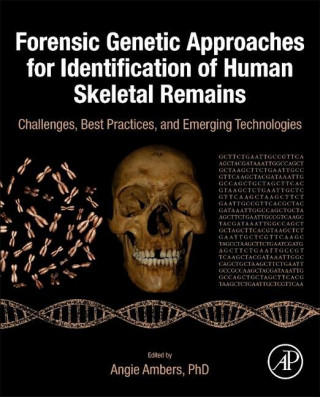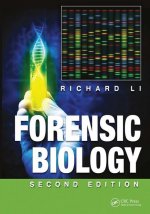
Kód: 33060992
Forensic Genetic Approaches for Identification of Human Skeletal Remains
Forensic Genetic Approaches for Identification of Human Skeletal Remains: Challenges, Best Practices, and Emerging Technologies provides best practices on processing bone samples for DNA testing. The book outlines forensic genetic ... celý popis
- Jazyk:
 Angličtina
Angličtina - Vazba: Pevná
- Počet stran: 500
Nakladatelství: Elsevier Books, 2022
- Více informací o knize

4501 Kč

Skladem u dodavatele v malém množství
Odesíláme za 10-14 dnů
Potřebujete více kusů?Máte-li zájem o více kusů, prověřte, prosím, nejprve dostupnost titulu na naši zákaznické podpoře.
Přidat mezi přání
Mohlo by se vám také líbit
-

Forensic Biology
2654 Kč
Dárkový poukaz: Radost zaručena
- Darujte poukaz v libovolné hodnotě a my se postaráme o zbytek.
- Poukaz se vztahuje na celou naši nabídku.
- Elektronický poukaz vytisknete z e-mailu a můžete ihned darovat.
- Platnost poukazu je 12 měsíců od data vystavení.
Více informací o knize Forensic Genetic Approaches for Identification of Human Skeletal Remains
Nákupem získáte 450 bodů
 Anotace knihy
Anotace knihy
Forensic Genetic Approaches for Identification of Human Skeletal Remains: Challenges, Best Practices, and Emerging Technologies provides best practices on processing bone samples for DNA testing. The book outlines forensic genetics tools that are available for the identification of skeletal remains in contemporary casework and historical/archaeological investigations. Although the book focuses primarily on the use of DNA for direct identification or kinship analyses, it also highlights complementary disciplines often used in concert with genetic data to make positive identifications, such as forensic anthropology, forensic odontology, and forensic art/sculpting. Unidentified human remains are often associated with tragic events, such as fires, terrorist attacks, natural disasters, war conflicts, genocide, airline crashes, homicide, and human rights violations under oppressive totalitarian regimes. In these situations, extensive damage to soft tissues often precludes the use of such biological samples in the identification process. In contrast, bone material is the most resilient, viable sample type for DNA testing. DNA recovered from bone often is degraded and in low quantities due to the effects of human decomposition, environmental exposure, and the passage of time. The complexities of bone microstructure and its rigid nature make skeletal remains one of the most challenging sample types for DNA testing. Provides best practices on processing bone samples for DNA testing Presents detailed coverage of proper facilities design for skeletal remains processing, selection of optimal skeletal elements for DNA recovery, specialized equipment needed, preparation and cleaning of bone samples for DNA extraction, and moreHighlights complementary disciplines often used in concert with genetic data to make positive identifications, such as forensic anthropology, forensic odontology, and forensic art/sculpting
 Parametry knihy
Parametry knihy
4501 Kč
- Plný název: Forensic Genetic Approaches for Identification of Human Skeletal Remains
- Podnázev: Challenges, Best Practices, and Emerging Technologies
- Jazyk:
 Angličtina
Angličtina - Vazba: Pevná
- Počet stran: 500
- EAN: 9780128157664
- ISBN: 0128157666
- ID: 33060992
- Nakladatelství: Elsevier Books
- Hmotnost: 450 g
- Rozměry: 235 × 191 mm
- Datum vydání: 01. July 2022
Oblíbené z jiného soudku
-

Dune
262 Kč -

Haunting Adeline
620 Kč -

Berserk Deluxe Volume 2
1092 Kč -

White Nights
90 Kč -

Powerless
276 Kč -

Atomic Habits
338 Kč -

Dune Messiah
183 Kč -

Berserk Deluxe Volume 3
1142 Kč -

One Day
276 Kč -

Berserk Deluxe Volume 1
1115 Kč -

Iron Flame
462 Kč -

Surrounded by Idiots
316 Kč -

Harry Potter and the Prisoner of Azkaban (Minalima Edition)
688 Kč -

Gravity Falls Journal 3
440 Kč -

Heaven Official's Blessing: Tian Guan Ci Fu (Novel) Vol. 1
440 Kč -

The Creative Act
586 Kč -

Dune
276 Kč -

Hunting Adeline
624 Kč -

A Little Life
276 Kč -

Children of Dune
174 Kč -

Heaven Official's Blessing: Tian Guan Ci Fu (Novel) Vol. 2
399 Kč -

Bungo Stray Dogs, Vol. 8 (light novel)
367 Kč -

Percy Jackson and the Olympians 5 Book Paperback Boxed Set
953 Kč -

Solo Leveling, Vol. 1
443 Kč -

The Prisoner's Throne
249 Kč -

Court of Thorns and Roses
254 Kč -

Cry Baby Coloring Book
255 Kč -

Fourth Wing
420 Kč -

Icebreaker
199 Kč -

Berserk Deluxe Volume 6
1089 Kč -

Avatar, the Last Airbender: The Kyoshi Novels (Box Set)
750 Kč -

The 48 Laws of Power
601 Kč -

House of Leaves
541 Kč -

Twisted Lies
213 Kč -

Dune Messiah
277 Kč -

No Longer Human
339 Kč -

48 Laws Of Power
480 Kč -

Twisted Games
213 Kč -

Caraval Paperback Boxed Set
905 Kč -

Solo Leveling, Vol. 2
479 Kč -

Open Circuits
910 Kč -

Berserk Deluxe Volume 5
1119 Kč -

Heaven Official's Blessing: Tian Guan Ci Fu (Novel) Vol. 3
441 Kč -

Berserk Deluxe Volume 4
1178 Kč -

Court of Mist and Fury
254 Kč -

SOLO LEVELING V08
431 Kč -

English File Upper Intermediate Multipack A (4th)
487 Kč -

CHAINSAW MAN V14
249 Kč -

Before the Coffee Gets Cold
276 Kč
Osobní odběr Praha, Brno a 12903 dalších
Copyright ©2008-24 nejlevnejsi-knihy.cz Všechna práva vyhrazenaSoukromíCookies


 Vrácení do měsíce
Vrácení do měsíce 571 999 099 (8-15.30h)
571 999 099 (8-15.30h)